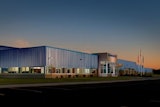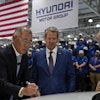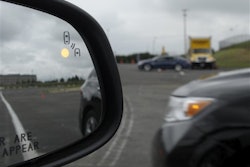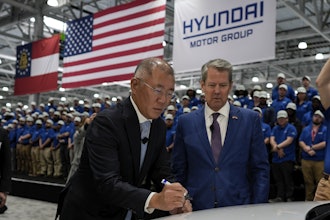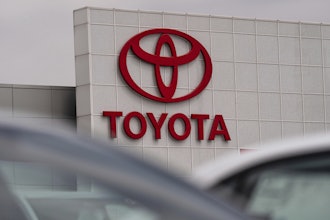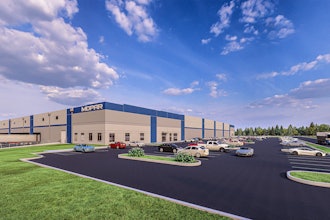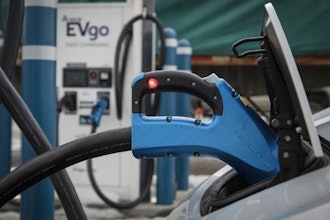CamShaft in tray for feed into automated production line. Image courtesy of Sohner Plastic.
Virtually all automotive dunnage is custom. After design and production of dunnage trays, the cycle of shipping parts and returning the trays after production to re-fill with parts again continues until the vehicle design itself is retired. At that point the packaging material is recycled for future use.
Building Dunnage
Once the dies are created and molds set up, injection molding offers the benefit of creating parts very rapidly. Drawbacks include high die cost, long lead times, and injection molding equipment maintenance. Because of this, thermoforming has been gobbling up the market for critical automotive dunnage simply because it takes less time, has lower costs for initial setup, and can be done using vacuum pressure and /or direct mechanical force. Plus, the process can take advantage of the latest in rugged materials and provide the close tolerances, tight specifications, and sharp detail that are needed for durable, reusable dunnage.
Thermoforming Details
Thermoforming basically produces parts from a flat sheet of plastic under high temperature and pressure. It provides close tolerances, tight specifications, and sharp detail. Advanced finishing techniques result in thermoformed products equal or better than those formed by injection molding. Vacuum thermoforming, press molding, fabrication, drape moulding, and many more technologies are used in thermoforming.
Tolerances of +/– 0.005’‘ from part to part may be necessary for the automation to work properly for robotic loading and unloading. While extremely difficult and expensive to try to do with injection molding — and not always successful — this is not a problem for thermoforming.
Materials
The material used to create the trays must fit the exact needs of the end use.While almost all standard dunnage for various industries, and even some automotive dunnage, are manufactured from standard forms of plastic, high-precision trays used for critical parts packaging, handling, and delivery systems often use special materials. The most common are:
- ABS (Acrylonitrile butadiene styrene): is the most common plastic for automation dunnage trays and packaging. The most important mechanical properties of ABS are impact resistance and toughness.
- ABS-TPU: This material is co-extruded with a rigid base layer of ABS and a cut resistant cover of TPU (Thermoplastic polyurethanes), which is a class of polyurethane plastics with many useful properties, including elasticity, transparency, and resistance to oil, grease, and abrasion. Extremely damage resistant, ABS/TPU cannot be cut by the sharp machined edges of the parts.
- Conductive HDPE (High-density polyethylene): HDPE Protects parts/components against Electrostatic discharge (ESD). This may occur between the charged surfaces and the grounded objects in the immediate vicinity, and can lead to undesired interference or damage of sensitive electronics in devices and sensors. HDPE is commonly recycled, and has the number “2” as its recycling symbol
- HMWPE (High Molecular Weight Polyethylene): HMWPE is very light weight and offers good wear and abrasion resistance. It resists water and chemicals, and provides high-mechanical strength. It is also very good for electrical insulation with high-dielectric properties.
- TriPly: This is a new, three-layer polypropylene composite consisting of a central structural sheet sandwiched between two smooth exterior sheets. The key feature is the design of the geometry of the middle structural sheet, which provides the exceptional rigidity in all directions. Constant wall thickness improves the quality of the welded bond between the structural middle and the outer sheets, further improving rigidity. Polypropylene is 10 percent recyclable.
All the above materials have a place in automotive dunnage, however the requirements of each specific application will determine which is best for the design and application.
Dunnage users come from all areas: end assembly users, contract manufacturers, consulting firms, and parts manufacturers. All have the same goals in common; they must meet the specific needs and desires of the end automotive manufacturer. Three of these are Returnable Packaging Solutions, (RPS) (Dexter, MI), Ghafari Associates (Dearborn, MI), and Hinkle Manufacturing, Inc. (Perrysburg, OH).
Applications
RPS interfaces with all areas of the auto parts manufacturing dunnage needs, specializing on shipping trays for finely tooled gears, clutches, transmission parts, and other assemblies that often have very sharp and detailed edges.
Ghafari is a leading full-service architecture and engineering organization that provides program management and consulting for industrial and process engineering, including dunnage.
Hinkle provides full service for their automotive customers. “We design, develop, and manufacture the packaging that takes parts from wherever they are being manufactured to their end destination,” says Taber H. (“Tab”) Hinkle, president and CEO.
Phil Krasny, RPS account executive says, “The whole point of reusable dunnage is to reduce steps and streamline the process from part manufacture to building the final assembly. Developing a single design that works for the component supplier, the manufacturing line, and the final customer saves a substantial amount of time and cost and reduced potential errors by eliminating unnecessary operator handling.”
“All our work is custom,” Krasny says. “Our end customers provide a part, or dimensions to us. Then we meet with dunnage manufacturer after sending them a specification outline that details the project and anything that is critical. When launching a new program, this can often take many months for all to agree on the best design.”
For almost all RPS applications, thermoformed ABS-TPU material is used. The cut-resistance is extremely important when handling large assemblies and parts with sharp edges. Krasny performed laboratory tests at GM on materials. The test dunnage, with nested parts, was subjected to the modified ASTM D4169 Truck Assurance Level II random vibration profile for 180 minutes.
“ABS-TPU proved superior and it is very good with rejecting moisture or oil, which can also be a concern. After years of use, you just wash and dry it, and it looks like the day you bought it,” Krasny says.
Ghafari manages the design and purchase of all of the containers, the dunnage; the specifications and how many are required from the beginning of the program to the official launch. Greg Brenny, Senior Project Engineer at Ghafari, says “Chrysler is one of our customers that has different programs for different vehicles. We will coordinate between all suppliers and all the different groups at Chrysler. We manage the process and work with the fabrictor to make sure they meet the Chrysler specs. Containers are then shipped to the parts manufacturer. This supplier will ship them to Chrysler.”
Because Ghafari works as a point of contact for all involved in the process, Brenny says that it is very important to select the right vendor for the right product because, once accepted, they will typically run the orders for dunnage multiple times.
“Every project has its challenges. The vendors we use will look at all issues, stand behind their product, and make any adjustments. If Chrysler changes something mid-stream the dunnage provider must be able to do it. It is a continual moving target, and that’s one of the big reasons we are hired to manage all of this for Chrysler,” Brenny adds.
Because Hinkle is a design and manufacturing house, they create the initial dunnage only at the beginning of the automotive part product launch. Most of their dunnage is designed for sequencing.
Sequencing dunnage holds multiple parts for assembly on multiple vehicles simultaneously. A sequence in the tray indicates which vehicle the part number goes on. The tray will be presented to a line using in-line sequencing to serve up parts to multiple vehicles simultaneously. This is typically handled manually, so it has to be rugged, but still operator friendly.
Hinkle’s interest is strictly with Sohner’s TriPly material. “A sequencing pack typically makes as many trips in one day as a standard pack makes in a year. That’s one of the niches where TriPly fits. It is more expensive than plastic corrugated, but it is much more durable,” Hinkle says.
“The middle sheet structure provides exceptional rigidity in all directions. And a welded bond between the structural middle and the outer sheets, further improves rigidity,” Hinkle says. “Because it is manufactured in 2,100 mm width and any required length, it is an easy fit for us. The fact that Polypropylene is 100 percent recyclable is a plus.”
Hinkle adds that they fabricate through die cutting, hot air welding, gluing, and a number of different processes. “We have a unique process where we can actually thermally die-cut the material, and when we do that with the Tri-Ply material, it makes the material easier to fabricate and cauterizes the edges so debris does not get inside the material,” he says.
All agree that using modern methods, whether thermoforming, thermal die-cutting, or hot air welding, the resulting cost of all tooling is ten times lower than the tooling required for injection molding and can commonly be produced much faster. Also, lower prototyping costs allow for more time on final design modifications if needed.
All automotive dunnage must meet the needs of an ever-changing automotive industry. Dunage providers are always working to come up with new materials and processes that will increase life-cycle durability, and streamline the job of the end manufacturer.
